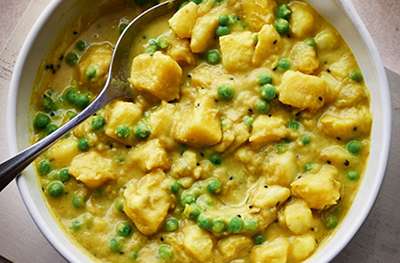0 added
Item price
£2.00Price per unit
£2/litre
Please note, we take every care to ensure the product, allergen and recipe information displayed is correct. However, should a product be unavailable, alternatives may be displayed and/or a substitution provided. If you have an allergy or intolerance, please always check the product label before use.
Heat the oil in a large saucepan over a medium-high heat. Add the onion and garlic then fry for 2-3 minutes until starting to soften. Meanwhile, rinse the cut potatoes well, shuffling them in a bowl of cold water to release as much starch as possible; set aside.
Add the spices and salt to the onions and fry for 1 minute more, then add the potatoes, turning to coat in the spices. Add 250ml cold water, bring to the boil then lower to a brisk simmer for 20 minutes, stirring regularly to make sure the potatoes cook evenly.
Stir in the peas and coconut cream then simmer for 3-4 minutes more. Serve with the coriander, green chilli and lime wedges, if using. Some flatbreads or steamed rice would go nicely, too.
Leftovers: Potato peelings
Hold on to those Maris Piper peelings! They’re full of fibre and delicious roasted with oil, paprika and a pinch of salt.
Typical values per serving when made using specific products in recipe
Energy | 1,414kJ/ 337kcals |
|---|---|
Fat | 13g |
Saturated Fat | 7.9g |
Carbohydrates | 45g |
Sugars | 7.5g |
Fibre | 7.4g |
Protein | 6.9g |
Salt | 0.7g |
Book a slot to see product availability at your nearest Waitrose & Partners store
0 added
Item price
£2.00Price per unit
£2/litre0 added
Item price
16p each est.Price per unit
£1.05/kg0 added
Item price
80pPrice per unit
26.7p each0 added
Item price
£2.20Price per unit
£1.10/kg0 added
Item price
£1.80Price per unit
£42.86/kg0 added
Item price
£1.80Price per unit
£47.37/kg0 added
Item price
£2.75Price per unit
£11/kg0 added
Item price
£1.90Price per unit
£5.43/kg0 added
Item price
£1.25Price per unit
£1.73/kg0 added
Item price
£1.30Price per unit
£8.13/litre0 added
Item price
85pPrice per unit
£34/kg